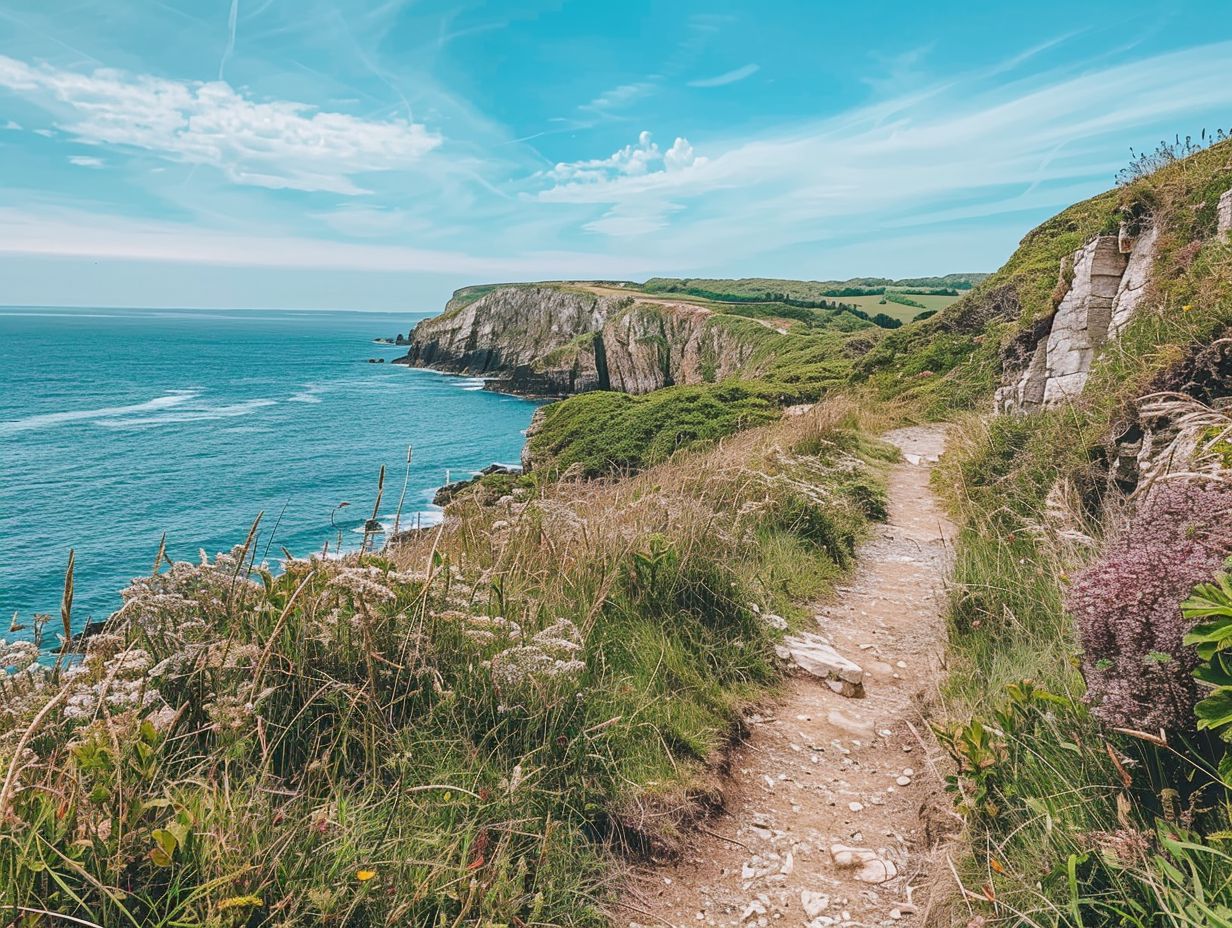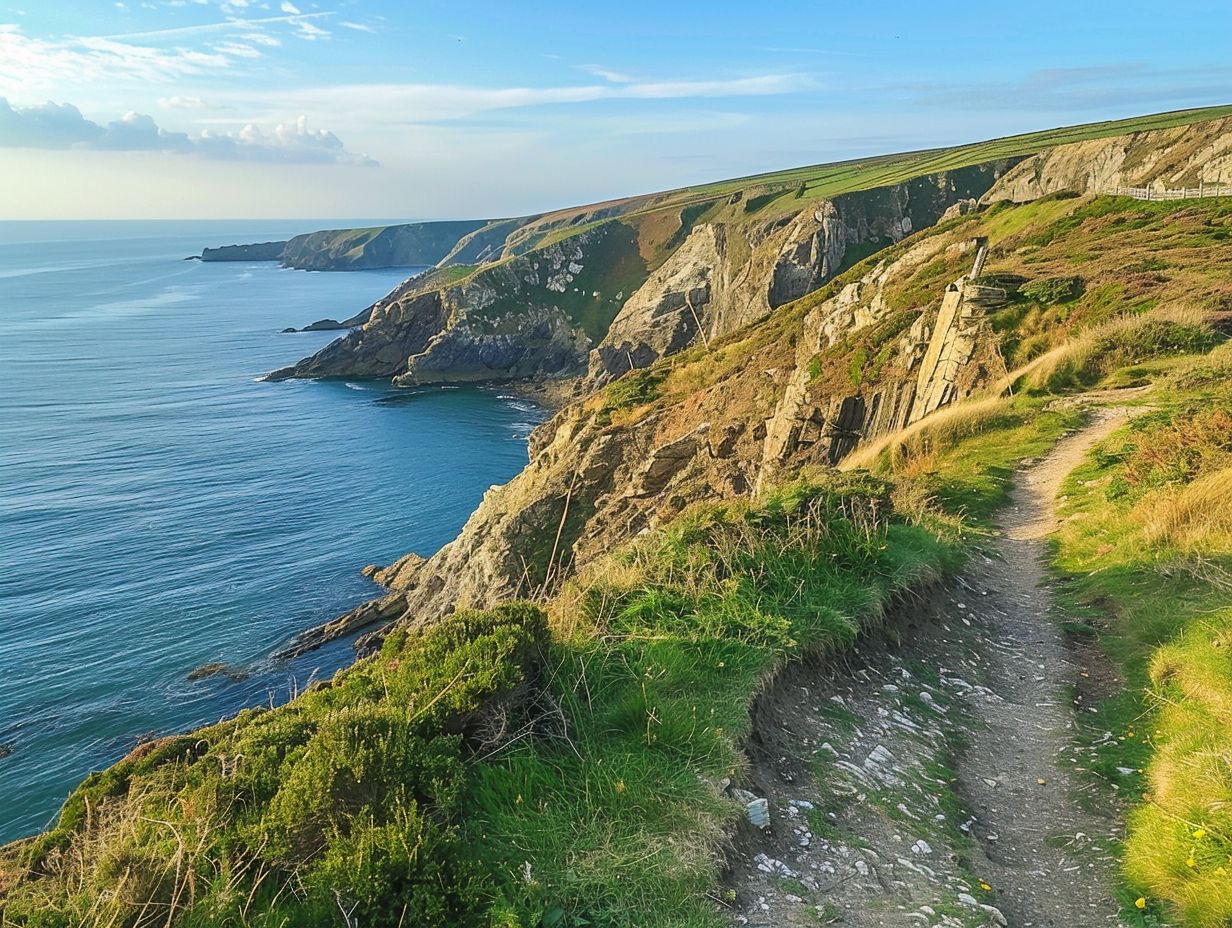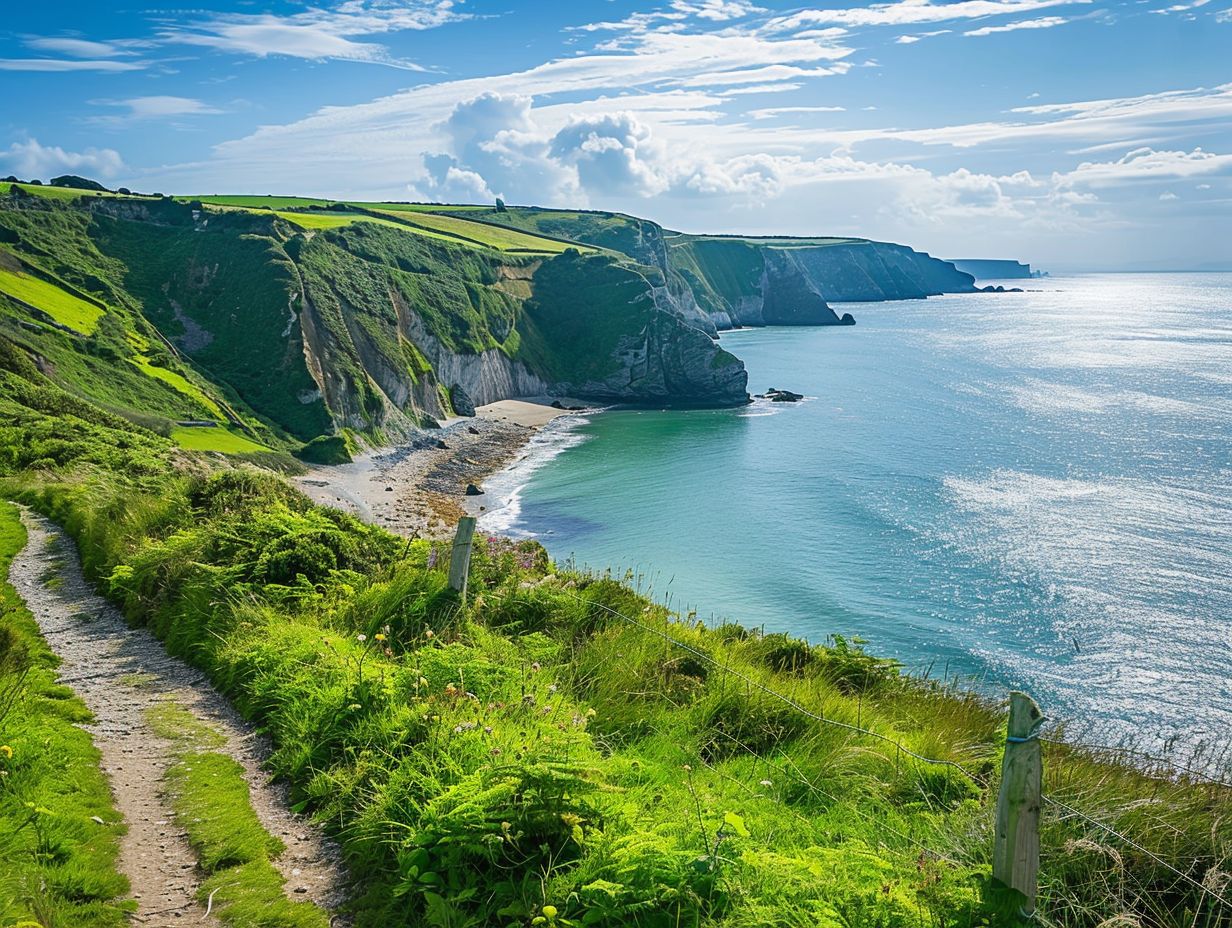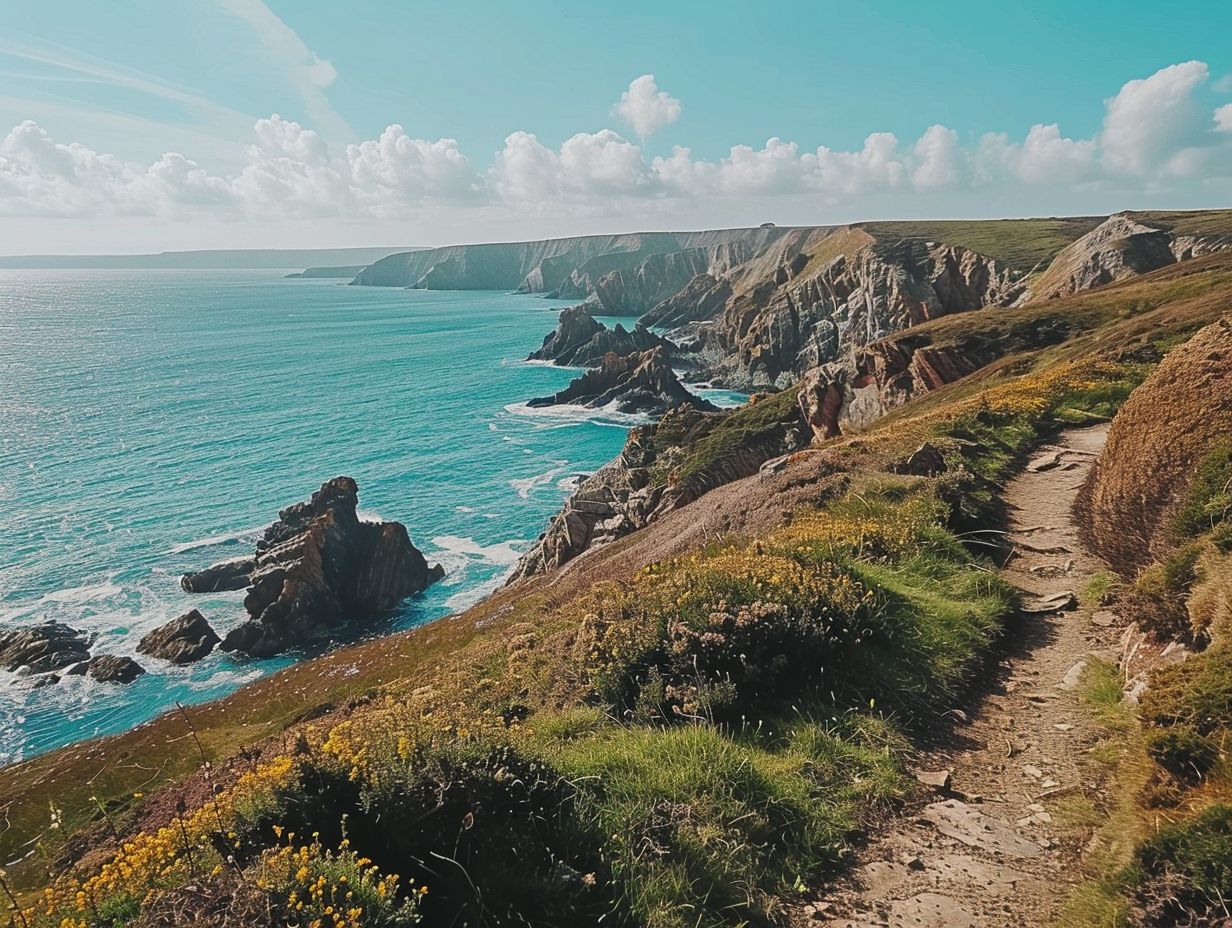

Vaibhav
- Categories: Hiking
Are you ready to embark on a journey along the stunning South West Coast Path? From breathtaking scenery to unique wildlife and historical landmarks, this article will guide you through the highlights of this iconic trail.
Whether you are planning your route, looking for accommodations, or seeking hiking tips, we have got you covered. Discover the best sections of the South West Coast Path in Cornwall, Devon, and Dorset, and get ready for an unforgettable adventure along this picturesque coastline.
Key Takeaways:

- The South West Coast Path offers stunning scenery, unique wildlife, and historical landmarks, making it a must-see destination for nature lovers and history buffs alike.
- When planning a trip to the South West Coast Path, make sure to choose the right route, plan your accommodations and packing essentials, and be prepared for changing weather.
- The best sections of the South West Coast Path are found in Cornwall, Devon, and Dorset, each offering their own unique landscapes and experiences for hikers to enjoy.
What are the Highlights of the South West Coast Path?
The South West Coast Path, recognised as a prominent National Trail, presents a multitude of attractions ranging from breathtaking landscapes in Exmoor National Park to the renowned Jurassic Coast. Its extensive route incorporates a wealth of historical landmarks, quaint towns, and picturesque villages.
1. Beautiful Scenery
The South West Coast Path offers a captivating experience characterised by its stunningly beautiful scenery, which varies throughout different stages and encompasses the verdant landscapes of Exmoor National Park and the imposing cliffs of the Jurassic Coast.
As individuals traverse this path, they will encounter a diverse array of landscapes, ranging from expansive moorlands to rugged coves. Particularly notable is the segment near Lulworth Cove in Dorset, renowned for its picturesque turquoise waters and the iconic rock formation of Durdle Door, which serves as a striking backdrop for outdoor enthusiasts.
Further along the path, the challenging terrain of Land’s End provides sweeping views of the Atlantic Ocean, establishing it as an essential destination for those in search of awe-inspiring panoramas. To aid hikers in planning their journey and fully appreciating the breadth of natural beauty along the South West Coast Path, detailed maps and stage descriptions are readily available.
2. Unique Wildlife
The South West Coast Path serves as a sanctuary for unique wildlife, offering walkers the opportunity to encounter a diverse range of fauna along the route, particularly in protected areas such as Exmoor National Park. The rugged cliffs and coastal heathlands that line the path provide optimal habitats for various seabird species, including puffins, razorbills, and fulmars.
During a leisurely stroll along the path, observers are encouraged to be vigilant for the sight of playful grey seals sunbathing on rocky outcrops or swimming in the waters below.
Within the lush woodlands of the area, fortunate visitors may be fortunate to catch a glimpse of elusive species such as red deer and otters. It is imperative to preserve these natural habitats to safeguard the continued existence of these captivating creatures and uphold the delicate ecological equilibrium of the region.
3. Historical Landmarks
The South West Coast Path is adorned with historical landmarks, featuring prominent sites such as Minehead, Poole, and Lizard Point that provide substantial historical context and captivating narratives.
Whilst traversing the path, one will have the opportunity to witness the impressive ruins of Corfe Castle, which overlooks the Jurassic Coast, offering insight into medieval times and the English Civil War.
Continuing along the trail, the venerable port town of Dartmouth presents its maritime heritage through the historic Dartmouth Castle, a formidable stronghold protecting the entry to the River Dart.
Upon reaching Land’s End, the westernmost point of England, visitors will encounter remnants of Iron Age settlements that underscore the region’s ancient origins and significance. Each of these landmarks contributes layers of history and intrigue to the journey along the South West Coast Path.
How to Plan for the South West Coast Path?
The preparation for hiking the South West Coast Path necessitates comprehensive planning. This includes referencing reputable guidebooks like those authored by Paddy Dillon, utilising GPX files for navigation, and segmenting the trail into manageable stages in order to optimise the overall walking experience.
1. Choosing the Right Route

The selection of the appropriate route along the South West Coast Path is of paramount importance. This renowned trail commences at Minehead and concludes at Poole, encompassing a variety of stages that differ in difficulty levels and showcase notable locations.
When making a decision regarding the route to undertake on the South West Coast Path, it is imperative to take into account one’s physical fitness level and personal interests. Individuals in pursuit of a demanding hiking experience may find sections such as the rugged cliffs of Exmoor or the steep inclines near Dartmouth appealing.
Conversely, those seeking a more relaxed journey can choose to explore the charming coastal villages of Cornwall or the tranquil woodlands along the Jurassic Coast.
Each segment of the path presents distinct attractions and obstacles, catering to the diverse preferences and capabilities of every hiker. This ensures that each individual can discover a section that aligns with their preferences and abilities effectively.
2. Accommodations and Camping
Accommodation options available along the South West Coast Path exhibit a wide range of diversity, encompassing camping sites to high-end accommodations situated in towns and villages, catering to a variety of preferences and financial capabilities.
Camping sites have emerged as a popular selection among budget-conscious travellers who wish to fully immerse themselves in the natural surroundings along the path. These sites typically provide fundamental amenities such as toilets and showers, appealing to individuals who appreciate a more rustic and close-to-nature experience.
Moreover, budget-friendly alternatives such as hostels and guesthouses are strategically positioned along the path, delivering straightforward yet comfortable lodging options for hikers operating on constrained financial resources.
For those desiring a more lavish and upscale experience, premium lodging options like boutique hotels and bed-and-breakfast establishments are available, offering indulgent amenities and breathtaking views of the coastline.
Given the demand, it is advisable to make advance reservations, particularly during peak seasons, to secure your preferred accommodation arrangements.
3. Packing Essentials
When preparing for the South West Coast Path, it is important to ensure that one’s packing includes essential items such as a comprehensive walking kit, appropriate gear for diverse weather conditions, and detailed maps for a safe and enjoyable journey.
Plus these fundamental necessities, it is imperative to include sturdy and comfortable hiking boots to safeguard one’s feet when traversing the rugged terrain. Equally crucial is the inclusion of lightweight and moisture-wicking clothing to maintain dryness and comfort while on the trail.
Other essential items that should be considered for the journey are a durable backpack equipped with an adequate water supply, a first aid kit for potential emergencies, and either a compass or GPS device for navigation purposes.
Ahead of embarking on the journey, it is advisable to review the weather forecast and have contingency plans in place for sudden changes in weather conditions. Reliable maps play a critical role in ensuring navigation along the correct path and facilitating easy traversal through various sections of the trail.
Tips for Hiking the South West Coast Path
Embarking on a trek along the South West Coast Path requires careful attention to a variety of recommendations to ensure a safe and enjoyable outing. These recommendations include, among others, wearing appropriate footwear, expecting changing weather conditions, and bringing an abundant supply of water and snacks.
1. Wear Appropriate Footwear
It is imperative to wear appropriate footwear when embarking on a hike along the South West Coast Path. Selecting the correct walking gear is essential not only to prevent injuries but also to ensure comfort throughout the entirety of the journey.
Whether one opts for hiking shoes or boots, the choice of footwear plays a critical role in navigating the various terrains encountered along the trail.
For leisurely coastal walks, lightweight hiking shoes with reliable grip often suffice. However, if the trek includes more challenging or steep sections, it is advisable to opt for sturdy hiking boots equipped with ankle support for added stability.
Properly fitted shoes or boots are instrumental in maintaining balance and reducing the likelihood of ankle sprains or blisters. Investing in high-quality footwear specifically designed for hiking can significantly improve the overall hiking experience by providing the necessary support and protection needed for extended periods of walking.
2. Be Prepared for Changing Weather
Being adequately prepared for changing weather conditions is essential when embarking on a hike along the South West Coast Path, as the coastal climate can be unpredictable. Ensuring that one has the appropriate walking gear and essential items packed can significantly impact the hiking experience.
Ahead of commencing the hike, it is highly recommended to consult the weather forecast to be informed of any potential weather changes.
Key essentials to bring include rain gear, such as a lightweight waterproof jacket and trousers, to remain dry in the event of unexpected showers. Additionally, layering clothing with moisture-wicking fabrics can assist in regulating body temperature in response to varying weather conditions.
Protection against sun or wind exposure can be achieved by packing a hat and gloves. Furthermore, it is advisable to carry a compact first aid kit, extra snacks, and an ample supply of water to ensure preparedness for any unforeseen circumstances that may arise during the hike.
3. Bring Plenty of Water and Snacks

It is essential to ensure that you are adequately prepared when undertaking a hike along the South West Coast Path, which includes bringing an ample supply of water and snacks. This preparation is crucial for maintaining proper hydration levels and sustaining energy throughout the duration of your walk.
It is important to recognise that maintaining adequate hydration is not solely about preventing dehydration but also about preserving energy levels and overall well-being.
Plus water, it is advisable to pack nutrient-rich snacks such as nuts, dried fruits, granola bars, or trail mix. These items offer a balanced combination of carbohydrates, protein, and fats, which are essential for sustaining energy during extended periods of hiking.
Investing in a high-quality hydration pack or water bottle that is convenient to carry is recommended to ensure that you have an adequate water supply to support you during your trek. By taking a proactive approach to hydration and snack provisions, you will be better equipped to fully appreciate the magnificent views and challenging terrain of the South West Coast Path.
What are the Best Sections of the South West Coast Path?
The most notable segments of the South West Coast Path showcase its most captivating regions, featuring distinctive landscapes, notable landmarks, and memorable opportunities for walking in Cornwall, Devon, and Dorset.
1. Cornwall
Cornwall, a prominent feature of the South West Coast Path, showcases breathtaking coastal panoramas, historical landmarks like Lizard Point, and lively urban centres such as St Ives and Padstow, where patrons can indulge in locally sourced seafood dishes, including culinary creations by esteemed chef Rick Stein.
Whilst traversing Cornwall’s idyllic landscapes, visitors will encounter picturesque fishing hamlets like Port Isaac and charming harbours such as Falmouth. The region’s rich history is intricately entwined with its rugged cliffs, with vestiges of ancient tin mines punctuating the coastal trails.
In terms of gastronomy, Cornwall offers a diverse culinary experience ranging from traditional Cornish pasties to delectable cream teas served in intimate tearoom settings. Guests are urged not to overlook the opportunity to meander through the lush gardens of the Lost Gardens of Heligan or marvel at the impressive architectural marvel of the Eden Project en route along the walking trail.
2. Devon
Devon presents a diverse fusion of natural splendour and historical landmarks along the South West Coast Path, showcasing notable features such as the quaint town of Exmouth and the historically significant Plymouth, home to the esteemed Plymouth Gin Distillery.
Exmouth, renowned for its breathtaking coastline, provides visitors with sandy beaches, picturesque seafront promenades, and exceptional opportunities for engaging in water sports such as sailing and windsurfing. The town’s dynamic marina and bustling cafes collectively establish an ideal maritime ambience.
Conversely, Plymouth, steeped in a rich maritime legacy, features attractions like the Mayflower Steps, from where the Pilgrim Fathers embarked on their journey to the New World, and the Royal William Yard, a chic waterfront development hosting an array of restaurants, art galleries, and artisan shops that are sure to enchant visitors.
3. Dorset
Dorset, known for its prominent feature of the iconic Jurassic Coast, holds a distinguished position within the South West Coast Path. This area offers walkers an array of striking geological formations and the delightful town of Poole. It is deemed an excellent choice for a memorable walking holiday, irrespective of the prevailing weather conditions.
The Jurassic Coast in Dorset holds the prestigious title of a UNESCO World Heritage Site, encapsulating a history of over 185 million years within its cliffs. Visitors can marvel at the awe-inspiring rock formations at Lulworth Cove and explore the fossil-rich beaches of Charmouth, encountering a plethora of natural marvels.
Poole, characterised by its bustling harbour and historical landmarks, presents an ideal blend of seaside tranquillity and cultural enrichment. For those contemplating a walking holiday in Dorset, it is advisable to pack layers to brace oneself for the variable weather conditions prevalent along the coast.
Frequently Asked Questions
What is the South West Coast Path?

The South West Coast Path is a long-distance hiking trail that spans 630 miles along the coastline of the South West region of England. It is the longest National Trail in the country and offers stunning views of the sea, coastline, and countryside.
How long does it take to complete the South West Coast Path?
The time it takes to complete the South West Coast Path varies depending on your hiking speed and how many breaks you take. On average, it takes between 4-8 weeks to complete the entire trail. However, many hikers choose to do it in smaller sections over a longer period of time.
Do I need to be an experienced hiker to complete the South West Coast Path?
No, you do not need to be an experienced hiker to complete the South West Coast Path. However, it is important to have a good level of fitness and be prepared for challenging terrain. You should also do your research and plan accordingly to ensure a safe and enjoyable hike.
Are there accommodations along the South West Coast Path?
Yes, there are several accommodations along the South West Coast Path including B&Bs, campsites, and hotels. It’s important to plan your route and book accommodations in advance, especially during peak hiking season.
What is the best time of year to hike the South West Coast Path?
The best time to hike the South West Coast Path is between April and October when the weather is milder and the days are longer. However, be prepared for some rain as the weather along the coast can be unpredictable. It’s also important to check for any trail closures or restrictions before starting your hike.
Can I bring my dog on the South West Coast Path?
Yes, you can bring your dog on the South West Coast Path, but they must be kept on a leash at all times. It’s also important to clean up after your dog and be respectful of other hikers and the environment. Some accommodations may also have specific policies regarding pets, so it’s best to check in advance.
Share:
By submitting your email address, you are agreeing to receive marketing emails from theexpertcamper.co.uk.
We’ll never share your email address and you can unsubscribe at any time. Privacy policy
Related Posts

A Seasonal Guide To Hiking In The Peak District
Are you ready to lace up your hiking boots and explore the stunning landscapes of the Peak District? This seasonal guide will take you through

Hiking Challenges Preparing For Your First Ultrahike
Are you ready to take your hiking adventures to the next level? Ultra-hiking offers a unique combination of physical and mental challenges, breathtaking scenery, and

Ecofriendly Hiking Tips For Sustainable Adventures
Are you an outdoor enthusiast looking to minimise your impact on the environment while enjoying the great outdoors? Eco-friendly hiking is the perfect solution! We

The Best Hiking Trails For Experiencing UK Wildlife
When exploring the picturesque hiking trails of the UK, you can expect to encounter a diverse array of wildlife. From majestic birds soaring overhead to

Wildflower Walks The Best Trails For Nature Lovers
Are you a nature lover looking to embark on a wildflower walk? Explore the best trails for wildflower walks, including [Trail Name 1], [Trail Name
























